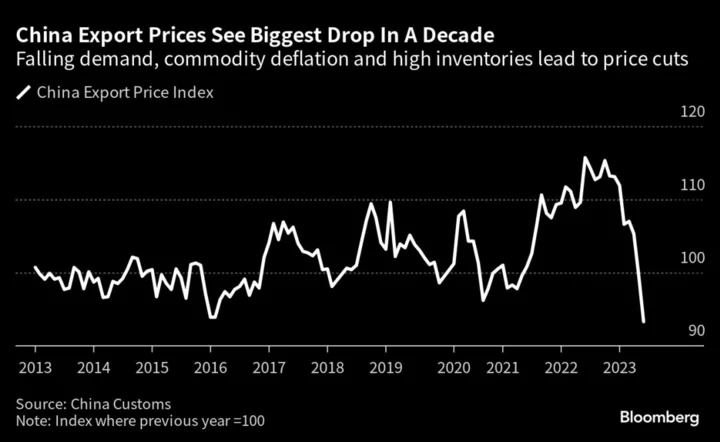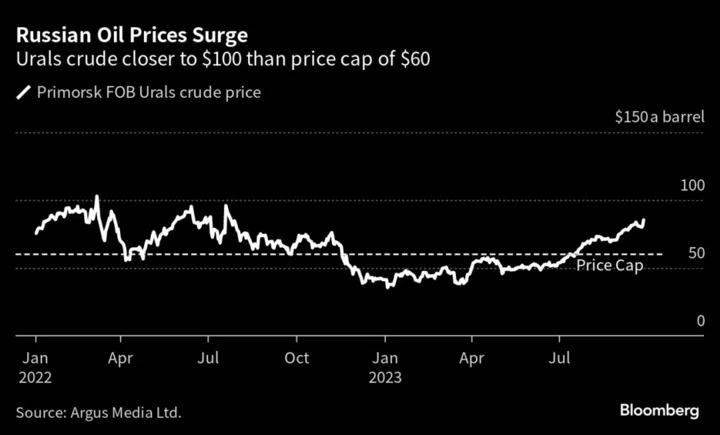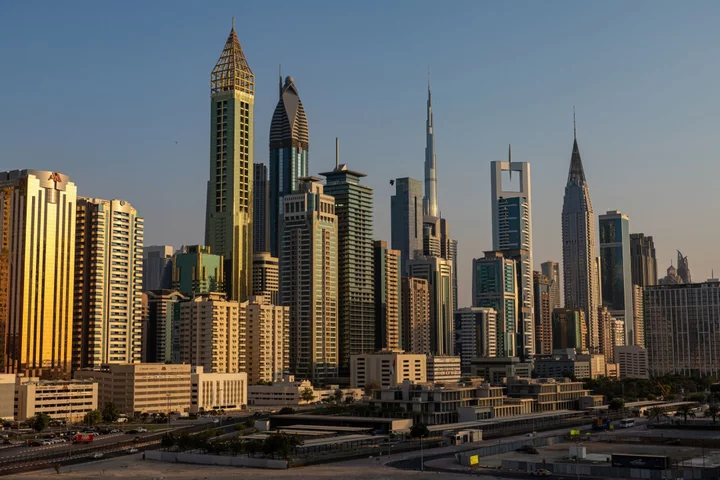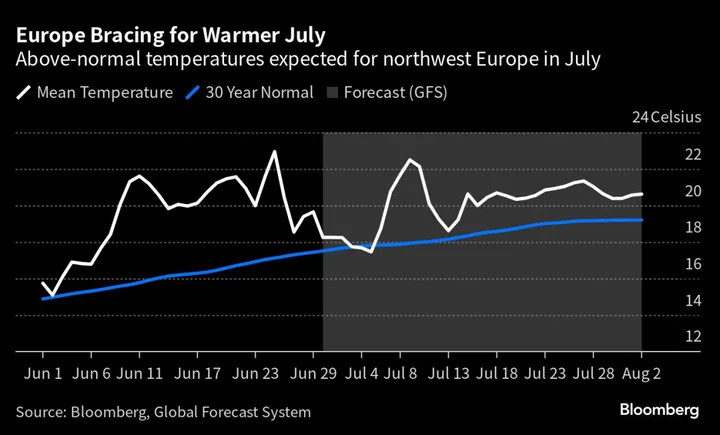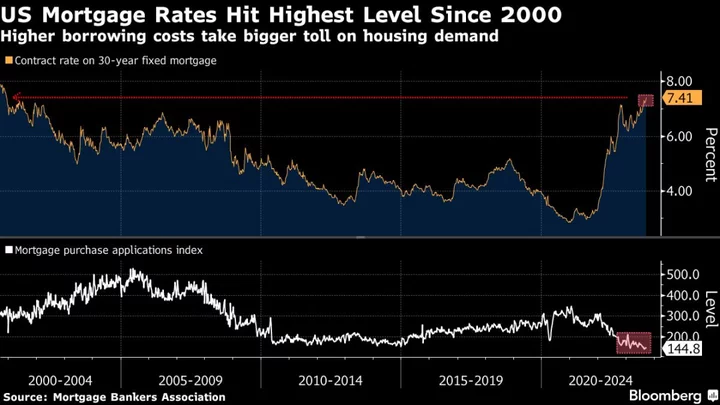July’s data left no doubt: China is now clearly dealing with a deflation threat. Consumer and producer prices fell together for the first time since 2020, adding to concerns about the health of the world’s second-largest economy. News that China’s prices are falling may be somewhat jarring, given the inflationary pressures in many other parts of the world. But the unique factors contributing to China’s problems are deep and ingrained. Solving them may not be an easy fix.
1. Why is China in deflation when other countries have inflation?
Inflation rocketed higher in the US and other major economies as they reopened after the Covid-19 pandemic, with pent-up demand fed at times by government handouts. At the start of this year some economists predicted the same would happen in China, which ended its Covid curbs later. But that hasn’t been the case. Consumer spending growth remains subdued, while a prolonged property slump has dented confidence, holding people back from buying big-ticket items and impacting prices for furniture and home appliances. Energy prices have been falling, too, given weakness in global commodity costs and Beijing’s long-standing control over the power sector. A price war among carmakers has added to deflationary pressures, while companies are also cutting prices to reduce the excess stock they built up over the pandemic. Prices aren’t falling across the board, however. Spending on services, such as travel and restaurants, has surged since pandemic restrictions ended, with prices continuing to rise in those sectors.
2. If everything is cheaper, isn’t that good for consumers?
Not really. Cheaper prices look good for consumers at first glance, but that doesn’t necessarily mean those shoppers will start spending money. When prices drop across a wide range of goods for an extended time, people start thinking it’s best to put off buying expensive items like appliances, thinking the price will continue to fall. That curbs economic activity even further, in turn forcing businesses to reduce their prices. For the consumers, that usually translates into earning less or losing jobs, which then results in less spending in a dangerous spiral downward.
3. What about the impact on businesses?
Lower prices generally lead to weaker revenue and profits, which then prompt companies to curb investment and hiring. Deflation also raises the level of “real,” or inflation-adjusted, interest rates in the economy. A rise in servicing costs for loans for businesses reduces their ability to invest, which in turn crimps demand, inducing more deflation. Some economists believe such “debt deflation” can trigger recessions or depressions as people default on their loans and banks are undermined. Look at Japan, where falling prices took hold in the 1990s and contributed to a prolonged period of stagnation that’s still haunting the world’s third-largest economy. The country is still dealing with the question of how to spur economic growth in a sustainable way. The Bank of Japan’s deployment of negative interest rates has done little to move the needle, prompting new tweaks to monetary policy this year.
4. How long is this deflation going to last?
Plummeting food and energy costs contributed heavily to the downward pressure on July’s figures, and some economists see those prices becoming less of a drag through the rest of the year. Factory-gate prices have been in deflation for longer, since October 2022. Even then, July’s reading marked a slight improvement from the previous month, suggesting some stabilization in producer prices. In general, China’s inflation has been on the low side for a decade, with economists citing a high household saving rates and high investment leading to rapid increases in industrial capacity as reasons.
5. What is Beijing likely to do about this?
The People’s Bank of China could cut interest rates further or reduce the amount of cash banks have to hold in reserve. The problem is the central bank faces several constraints, such as a weaker yuan and already elevated debt levels, especially at the local government level. Fiscal support — stimulus — has also been moderate given the financial strains, meaning authorities are less inclined to rely on big spending measures as in the past and instead turn to targeted strategies. Beijing has also encouraged regional authorities to find ways to get people to spend money, too.
6. What about foreign investors?
The clearest impact may be to corporate earnings, given the pressure on companies to cut prices during times of deflation. Where there’s a bit more upside is in bonds, which better protect investors during times of trouble. Concerns about growth and curbed investment usually prompt governments to deploy looser monetary policy, making a country’s bonds more attractive, too. However, Ken Cheung, chief Asia FX strategist at Mizuho Bank Ltd., said the yields on China’s sovereign debt are simply “too low compared to major markets” to be appealing to foreign traders.
7. What does this mean for the global economy?
There may be some benefits for developed countries, at least in the short term. As Chinese manufacturers cut prices to shed excess supply, that may ripple through to places like the US and Europe, providing some help for central banks there as they work to tame elevated inflation. There are some limitations: Both regions have become more protectionist in recent years and tried to limit their dependence on China. And Chinese-made goods make up a relatively small share of consumer spending in developed countries. For example, the US CPI (consumer price index) basket is dominated by shelter, food, energy and medical care, which have relatively little to do with imports from China. Emerging markets might welcome lower machinery prices — though with some caveats, as analysts have noted those countries may be wary about welcoming too much Chinese competition undercutting domestic industries.
8. Has this happened before?
Yes. Each time, in 2009, 2015 and 2020, Beijing responded with forceful monetary easing and large fiscal stimulus. While Beijing has vowed to accelerate some infrastructure projects and increase support for the slumping housing market this time, many economists aren’t expecting a large-scale building boom as in the past, as President Xi Jinping has been focused on shifting its economy toward new growth drivers, such as advanced technologies. That would make Beijing’s response more similar to its response to a 1998 period of deflation, which is now remembered as structural. Beijing recapitalized underperforming banks and downsized its state-sector ahead of joining the World Trade Organization.
- More QuickTakes on China’s weakening economy, Japan’s struggle to revive growth, and a glossary of inflation terms including disinflation.
- Bloomberg Opinion’s Daniel Moss examines China’s economic malaise.
- Eric Zhu from Bloomberg Economics looks for the price bottom for China.
- Chinese economists push back on the risk of a ‘balance sheet recession’ like Japan.
--With assistance from Fran Wang and Rebecca Choong Wilkins.

